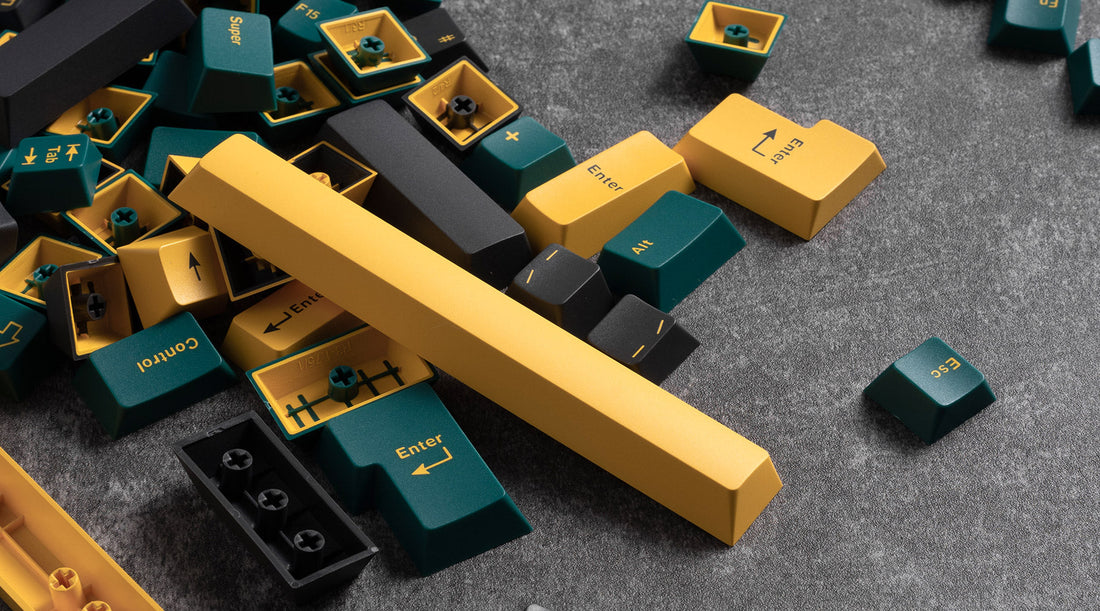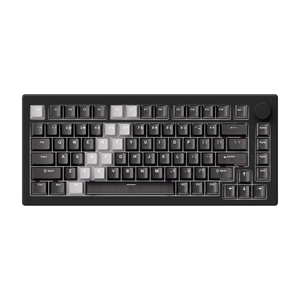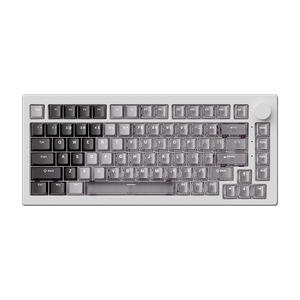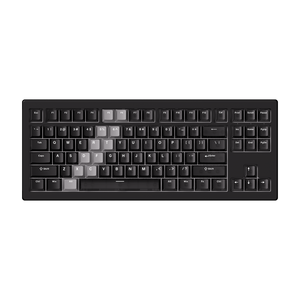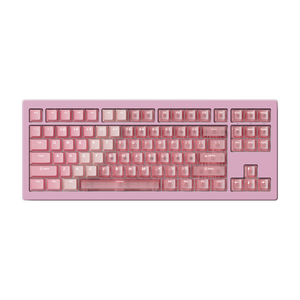Mechanical keyboards have regained popularity over membrane keyboards thanks to their durability and comfortable typing feel. They are now the first choice for enthusiasts and gamers. In addition to their long lifespan and excellent typing feel, mechanical keyboards offer another unique feature: customizable keycaps . This allows users to customize their keyboard to perfectly match their style and preferences—making each keyboard unique.
Keycaps come in a variety of shapes, sizes, colors, and materials. If you're a beginner, the choice can be overwhelming. This article will tell you everything you need to know about keycaps. I hope it will be helpful.
Keycap materials
1. ABS (acrylonitrile butadiene styrene)
ABS is an engineering thermoplastic. This material is inexpensive and versatile in its molding, making it widely used. ABS keycaps also offer better light transmission, making them particularly well-suited for mechanical keyboards with RGB lighting.
However, ABS keycaps tend to develop a shiny surface over time, especially with prolonged use and contact with finger oils.
Some high-end models use an additional layer of wear-resistant material to reduce oiling. However, this significantly increases production costs, which is why this coating is usually only found on higher-priced mechanical keyboards.

2. PBT (polybutylene terephthalate)
PBT is a type of polyester. Unlike ABS, this material is harder and offers a crisp, responsive typing feel. This makes PBT keycaps less susceptible to wear and the development of a shiny surface over time.
However, PBT has a higher melting point, which makes manufacturing and coloring more complex. Therefore, the colors of PBT keycaps are often less vibrant than those of ABS keycaps.

3. POM (polyoxymethylene)
POM is a crystalline thermoplastic. This material is characterized by a non-oily feel, high density, and a smooth, easy-gliding surface.
However, POM keycaps are available in limited colors, are more difficult to manufacture, and have higher production costs. They are less common but offer a unique typing experience.
Keycap manufacturing processes
Double shot
This process involves injecting two different colors of plastic into the keycaps. The characters on the keycaps are created by the color contrast of the two plastics used. This makes the letters extremely durable and virtually wear-resistant.
In addition, the combination of transparent and opaque materials can achieve light transmission, which is particularly advantageous for RGB keyboards.

Dye sublimation (thermo sublimation)
Dye-sublimation involves infusing color pigment into the surface of the keycaps at high temperatures, creating permanent lettering. This process makes the keycaps particularly abrasion-resistant and durable.
Another advantage of dye-sublimation is the ability to apply custom designs and patterns to the keycaps, such as anime characters, small animals, or special themed layouts.
However, dye-sublimation isn't suitable for translucent keycaps, so these keycaps are generally not compatible with RGB lighting.

Laser engraving (laser etching)
The characters are engraved into the surface of the keycaps with a laser. This process is cost-effective, but the engravings often feel slightly rough. Furthermore, the characters tend to peel off over time due to wear, reducing durability compared to other processes.
Keycap profile

Cherry profile
This profile is one of the most popular for custom keycaps. It originates from Cherry, and many recognize its height and shape as the standard. Cherry keycaps have a square shape, with individual rows varying in height.
They are lower in height than standard OEM keycaps and often more expensive. Those accustomed to mechanical keyboards will easily adapt to this profile.
Cherry keycaps produce a louder sound because they have less space inside to dampen the sound.

OEM profile
The OEM profile is the standard for most mechanical keyboards in the consumer sector and is also widely used in the custom market.
These keycaps have a slightly angled shape, with each row at a different height. This makes them ergonomically comfortable for typing and gaming.
OEM keycaps are usually the most affordable option for custom keycaps made of the same material. Most users can quickly adjust to this height, unless they're switching from a very flat profile, which can take a few weeks to get used to.
The sound of OEM keycaps is similar to that of Cherry keycaps—slightly rough—but differences in material and thickness have a greater impact on the sound.

SA profile
SA keycaps are the tallest on this list and may be unfamiliar to newbies, especially if they're coming from a keyboard with flatter keycaps.
This profile is known for its distinctive, rich sound, which many enthusiasts love. SA keycaps also give keyboards a retro look, making them especially appealing to fans of classic mechanical typewriters.
SA keycaps are less ideal for gaming, but excellent for typing. While some flatter profiles allow for faster typing, SA offers a particularly comfortable and satisfying typing experience.
ASA profile
The ASA profile was designed to provide a middle ground between OEM and SA keycaps. It's approximately 2 mm taller than OEM keycaps but 2 mm shorter than SA keycaps.
A distinctive feature of the ASA profile is the slightly sloped top surfaces. These ensure a comfortable typing experience, as your fingers rest naturally on the keys. The ergonomic incline reduces strain on your fingers during longer typing sessions.

DSA profile
DSA is a low profile with a consistent height across all rows.
It's easy to get used to, unless you're switching from SA, which creates a stark contrast due to its height. However, some users might find the round, edgeless keycaps a little odd.
DSA keycaps have a uniform height and a rounded design. They produce a deep sound and are particularly suitable for gaming, as they enable fast response times and cause less fatigue during extended use.
However, the uniform shape may require some getting used to when typing.
MDA profile
MDA keycaps have a medium height, making them a good compromise between the low DSA and high SA profiles.
They have a spherical surface with a slight depression so that your fingers can rest naturally on the keys.
Unlike Cherry or OEM keycaps, MDA keycaps do not have different heights for different rows, which contributes to a consistent typing feel.
JDA profile
The JDA profile has different heights. Compared to the SA, it's lower, making it a good choice for users who don't want to use a wrist rest.

XDA profile
Similar to DSA, XDA keycaps are low and evenly shaped. They are popular among enthusiasts because they offer a modern, minimalist aesthetic.
This profile is easy to get used to—those coming from SA keycaps will find it easier to adjust than with DSA. The biggest challenge might be the uniform height, which some people find difficult to get used to.
The sound of XDA keycaps is similar to that of Cherry keycaps, but slightly deeper.
XDA is suitable for both gaming and everyday typing. However, some gamers may have difficulty quickly locating certain keys due to the uniform height.
SAL profile
The SAL profile is a variant of the SA profile and is characterized by its high, spherical shape, adapting to the natural curvature of the fingertips, which ensures a comfortable typing experience.
OSA profile
The OSA profile is a uniform profile in which all keycaps have the same height regardless of their position on the keyboard.
It is lower than the SA profile and some variants of the Cherry profile, making it comfortable for users who prefer a flatter, more even layout.
Uniform vs. Sculpted Keycap Profile
The terms "uniform" and "sculpted" refer to the shape and height of the keycaps in the different rows of a keyboard.
Uniform keycap profile
With a consistent keycap profile, all keycaps have the same height and shape across all rows. This results in a symmetrical appearance and a consistent typing feel.
Popular uniform profiles are:
- DSA
- XDA
Sculpted keycap profile
Sculpted keycap profiles feature keycaps with different heights and shapes depending on the row. This allows them to adapt to the natural curve of the fingers, allowing for a more ergonomic hand position and a more comfortable typing experience.
Popular sculpted profiles are:
- SA
- Cherry
- OEM
- DCS

Keycap compatibility and layouts
Standard layouts
Keyboards come in a variety of layouts, with ANSI (American National Standards Institute) and ISO (International Organization for Standardization) being the most common. There are also different keyboard sizes, such as full-size , tenkeyless (TKL) , and compact layouts , each requiring different keycap sets.
➡️ Learn more about the difference between ANSI and ISO layout .
Keycap size and stamp compatibility
Keycaps must be compatible with the stem type of the switches used. Common stems are MX-compatible stems, which work with most mechanical keyboards.
Additionally, there are different keycap sizes , such as 1U, 1.25U, 2.25U, and 6.25U , which are required for different keyboard layouts. Make sure the keycaps you choose match the size and layout of your keyboard.
Choosing the right keycaps
1. Material preference
- ABS : Cost-effective, wide range of colors, smooth surface, but prone to gloss formation.
- PBT : Durable, textured surface, less prone to wear, but more expensive and limited color options.
- POM : Smooth and durable surface with a clear sound profile, but expensive and harder to produce.
2. Profile and shape
The shape and height of the keycaps significantly influence typing comfort:
- For gaming : Cherry or OEM profiles are ideal because the beveled shape shortens finger movements.
- For heavy typists : SA keycaps offer a unique typing feel and sound profile, but can take some getting used to.
- For quiet keyboards : Low-profile keycaps such as DSA and XDA in combination with silent switches reduce the noise.
3. Aesthetics and design
Keycaps are a great way to customize a keyboard. They come in a variety of colors, patterns, and designs—from minimalist styles to ornate or themed keycaps.
Akko offers a wide selection of styles and themes suitable for gamers, collectors, or office setups. So you can personalize your keyboard and express your own style.
What are pudding keycaps?
Pudding keycaps have a semi-transparent design that allows the keyboard backlight to shine through. They are usually made of PBT plastic and are especially popular for RGB-lit keyboards .
Advantages of pudding keycaps:
- Enhance RGB lighting for an eye-catching look.
- Increase typing comfort through a more pleasant feel.
- Reduce hand fatigue during longer writing sessions.
Conclusion
Keycaps are not only functional but also a way to express creativity and individuality. Whether you prefer the durability of PBT , the smooth typing feel of POM , or the versatility of ABS , there's a perfect material for your needs.
The right keycap profile also plays a big role:
- OEM & Cherry for ergonomic use.
- SA for a classic retro look with a unique sound.
- DSA & XDA for a minimalist and low design.
Customize your keyboard to perfectly match your style and comfort!

